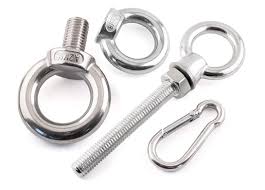Understanding Eye Bolts : 5 Factors To Consider
Eye bolts are one of the simplest and yet most often misused pieces of rigging equipment. There are several factors that must be considered when choosing and installing eye bolts. When eye bolts are used improperly, they can be damaged or broken leading to catastrophic accidents and injuries even when performing fairly basic lifts.
1. SHOULDERED VS. NON-SHOULDERED
The first item to consider is whether you need a shouldered or non-shouldered eye bolt.
Non-shouldered eye bolts are only designed to be used for completely vertical lifts. If you are going to be lifting with your slings at an angle or with any kind of angular loading, you will need to use a shouldered eye bolt. Even when using a shouldered eye bolt, you must be sure that it is installed properly before you can apply any type of angular loading to it. If the shoulder is not completely flush so that it can function properly, the shouldered eye bolt can only be used for vertical lifts.
S-279: FORGED EYE BOLT

G-291: REGULAR NUT EYE BOLT

G-277: SHOULDER NUT EYE BOLT

2. SLING ANGLE
 As the sling angle becomes smaller the tension being placed on the eye bolt increases while the eye bolts capacity diminishes drastically. It is very important that riggers understand this phenomenon completely in order to choose the proper eye bolt to make their lift safely.
As the sling angle becomes smaller the tension being placed on the eye bolt increases while the eye bolts capacity diminishes drastically. It is very important that riggers understand this phenomenon completely in order to choose the proper eye bolt to make their lift safely.
For example, when using a Crosby eye bolt with a tight sling angle of 30 degrees the tension applied to the eye bolts during the lift will be two times the weight of the load being lifted. At the same time, the eye bolt itself has been reduced to 25% of it's original capacity. Some manufacturers do not recommend that you use their eye bolts at an angle below 45 degrees. If you do not account for both the increase in tension and the loss of capacity, the rigger will overload your eye bolt, and you are running the risk of damaging your equipment or dropping the load.
DIN580 Lifting Eye bolt
3. CONNECTIONS
The third factor to consider when selecting the correct eye bolt for a lift is to take the dimensions of the eye bolt eye into account. You want to make sure that all hardware and rigging equipment that will be attaching to the eye bolt will fit comfortably into the eye and be able to function properly.
For instance, if hooks are being attached to the eye bolts, you need to make sure that the hook fits comfortably through the eye. The load should rest in the bowl of the hook, and the hook should be able to align itself with the sling leg and not get kinked when tension is applied.
4. ROTATION
 It is also important to realize that eye bolts are not designed to rotate under load, and that in order to function properly you must apply tension across the plane of the eye of the eye bolt. The eye bolt must be aligned during installation and tightened to secure it against rotation during lifting. This means the rigger must install the plane of the eye bolt inline with the sling leg. This is done using shims from the manufacturer. It is not recommended that you use more than one shim to align the eye bolt with the sling leg. The manufacturer should be able to provide you with a shim of the proper thickness to turn the eye bolt to the proper alignment.
It is also important to realize that eye bolts are not designed to rotate under load, and that in order to function properly you must apply tension across the plane of the eye of the eye bolt. The eye bolt must be aligned during installation and tightened to secure it against rotation during lifting. This means the rigger must install the plane of the eye bolt inline with the sling leg. This is done using shims from the manufacturer. It is not recommended that you use more than one shim to align the eye bolt with the sling leg. The manufacturer should be able to provide you with a shim of the proper thickness to turn the eye bolt to the proper alignment.
5. MATERIAL STRENGTH & THREAD DEPTH
The final aspect to consider for proper application of eye bolts is the strength and thickness of the material that the eye bolt will be installed into. Even if the eye bolt you choose is the correct style and capacity, the material into which you are installing it must be capable of surviving the forces that will be applied during the lift. You will want to look at the drawings or consult with an engineer to make sure that the load can be safely lifted with the number of pick points you are planning to use and their locations on the load.
- In an untapped through-hole, the nut shall be fully engaged. For vertical lifts where the shoulder isn't flush with the load, we recommend a second nut is used on the top of the load.
- In a tapped blind hole, the effective thread length must be at least 1 1/2 times the bolt diameter when installed in steel. Having at least 2 times the bolt diameter is highly recommended.
- In a tapped through-hole of less than one bolt diameter of thickness, a nut should be installed on the underside of the load and shall be fully engaged and tightened securely.
- For machinery eye bolts, minimum tap depth is the basic shank length plus 1/2 of the nominal eye bolt diameter.

